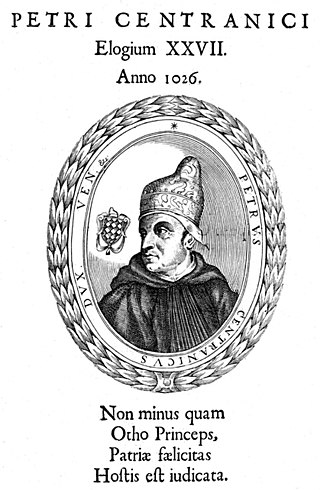
Cannaregio is the northernmost of the six historic sestieri (districts) of Venice. It is the second largest sestiere by land area and the largest by population, with 13,169 people as of 2007.

Vincenzo Scamozzi was an Italian architect and a writer on architecture, active mainly in Vicenza and Republic of Venice area in the second half of the 16th century. He was perhaps the most important figure there between Andrea Palladio, whose unfinished projects he inherited at Palladio's death in 1580, and Baldassarre Longhena, Scamozzi's only pupil.

The Grand Canal is a channel in Venice, Italy. It forms one of the major water-traffic corridors in the city.

Pietro Barbolano was the 28th Doge of Venice. Reportedly a descendant of the legendary Eraclea, he was elected by the assembly of the nobles after the deposition of his predecessor, Otto Orseolo. The dates of his birth and death are unknown.

The Scuola vecchia della Misericordia is a former charity building in Venice, Italy, in the sestiere of Cannaregio. It is located near the north margin of the city, at the intersections of Rio della Sensa and the confluence of Rio di Noale and Rio di San Falice.

The Palazzo Barbarigo Minotto is a 15th-century palace on the Grand Canal in Venice, northern Italy, next to the much larger Palazzo Corner. Built in the Venetian Gothic style, it was originally two palaces, Palazzo Barbarigo and Palazzo Minotto, later joined together. The Barbarigo palace was owned by the Barbarigo family for several centuries and was the birthplace of Gregorio Barbarigo, who once refused the Papal Crown. It was later owned by the Minotto and Martinengo families.

The Palazzo Pesaro Papafava or Palazzo Papafava is a 15th-century Gothic style palace in the sestiere of Cannaregio of Venice, Italy. Located on the Canale della Misericordia, near the corner with Rio di San Felice; it stands across from the Scuola Grande di Santa Maria della Misericordia.

The Palazzo Grandiben Negri is a small brick palace located facing the Rio of Ca' di Dio, adjacent to the larger Palazzo Erizzo, and diagonally across the rear of the church of San Martino in the sestiere of Castello in Venice, Italy.

The Palazzo Muti Baglioni is a Baroque architecture palace located near San Cassiano in the Sestiere San Polo of Venice, Italy.

The Ponte del Paradiso is a bridge located in Venice, Italy. Crossing the Rio del Mondo Novo, the bridge is almost entirely constructed out of Istrian stone bricks while the steps are paved with Trachyte. It is located within Castello, the largest of the Venetian sestieres. The bridge is known for the unique arch on its southern side serving as an entrance to the Calle del Paradiso, an alley famous for its wooden overhanging eaves.

The Palazzo Boldù a San Felice is a palace located on the Canal Grande of Venice, between the Palazzetto Da Lezze and Palazzo Contarini Pisani in the Sestiere of Cannaregio, Venice, Italy.

Palazzo Soranzo Piovene, also called Soranzo Piovene alla Maddalena is a Renaissance-style palace on the Grand Canal, located between the Palazzo Emo at Maddalena and the Palazzo Erizzo, in the sestiere of Cannaregio, in Venice, Italy.

The Palazzo Bernardo a San Polo, also known as the Giustinian Bernardo is a Gothic-style palace located between Palazzo Querini Dubois and across the Rio del la Madoneta, Casa Sicher, on the Grand Canal in the sestiere of San Polo of Venice, Italy.

Palazzo Donà Giovannelli is a civil building located in the city of Venice, Italy in the Cannaregio district. The palace neighbors Palazzo Pasqualigo Giovannelli and overlooks the Rio di Noale and the Rio di Santa Fosca.

The Moro family was a patrician family of the Republic of Venice.

The Zulian family was an old Venetian noble family. The place from whence the Zulian came to Venice is unclear; however, the family is considered one of the first that moved to Venice, and thus one of the oldest Venetian and Italian noble families. The family produced tribunes, and in the early 8th century gained dukedom, as a family member rose to the position of Maestro dei cavalieri. The family produced several prominent Venetian figures, including statesmen, generals, patrons and magnates.

Paolo "Polo" Zuliani was a Venetian nobleman, statesman, and Duke-elect of Candia, who is remembered for having declined the title of Duke of Candia out of modesty upon his election in 1382.

The Salamon family - sometimes Salomon or Salomoni - was a patrician Venetian noble family of ancient but uncertain origin, counted among the so-called “Case Vecchie” of the Republic of Venice.
Giuseppe Tassini was an Italian historian and one of the most notable scholars of the toponymy of his birthplace of Venice. His most notable work was Curiosità Veneziane, a minute toponymical study first published in 1863 and universally considered the most important bibliographical source of its kind.




















